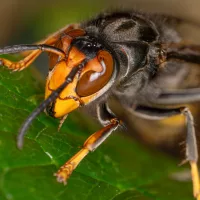
(NEW YORK) — The so-called “murder hornet” has been eradicated from the United States, five years after the invasive species was first discovered in Washington state, officials declared Wednesday.
There have been no confirmed detections of the northern giant hornet — the hornet’s official name — for the past three years, the Washington State Department of Agriculture and the U.S. Department of Agriculture said.
The eradication was the result of a yearslong effort to find and eliminate the hornets that involved state, federal and international government agencies, officials said.
“We are proud of this landmark victory in the fight against invasive species,” Dr. Mark Davidson, the deputy administrator at USDA’s Animal and Plant Health Inspection Service, said in a statement. “The success of this effort demonstrates what’s possible when agencies and communities unite toward a common goal.”
WSDA Director Derek Sandison said in a statement he was “incredibly proud of our team, which has dedicated years of hard work to safeguarding our state and the nation from this invasive threat to our native pollinators and agriculture.”
The public also played a large part in helping eradicate the pest by reporting sightings, officials said.
“Without the public’s support for this effort, it is unlikely we would be announcing the eradication of northern giant hornet today,” Sven Spichiger, WSDA’s pest program manager, said in a statement. “All of our nest detections resulted directly or indirectly from public reports. And half of our confirmed detections came from the public. The people of Washington can be proud that we did this by working together.”
The northern giant hornet, which is native to Asian countries including China and Japan, was first detected in North America in August 2019 in British Columbia, Canada. It was confirmed in Washington state four months later when a resident in Whatcom County reported a dead specimen. That incident appeared to be a separate introduction originating from a different country than the British Columbia one, officials said.
Four hornet nests found inside alder tree cavities in Whatcom County were eradicated between October 2020 and September 2021.
Trapping efforts continued in Whatcom County through 2024, and no additional hornets have been detected in the area, WSDA said.
A community member reported a “suspicious hornet sighting” in Kitsap County in October, though WSDA was unable to obtain the hornet to confirm the species, the department said. Traps placed in the area and public outreach did not yield any additional evidence or reports of suspected sightings, it said.
“All we can say is that the image appears to be a hornet of some kind. How it came to be in Kitsap County, we don’t know,” Spichiger said.
WSDA said it will conduct trapping in the area in 2025 as a “precautionary measure.”
The northern giant hornet could have posed a “significant threat” to honey bees and other pollinators had it become established in the U.S., officials said. The hornets can kill an entire honey bee hive in just 90 minutes. Their sting is also more painful than that of a typical honey bee.
“By tackling this threat head-on, we protected not only pollinators and crops, but also the industries, communities, and ecosystems that depend on them,” Davidson said.
Copyright © 2024, ABC Audio. All rights reserved.















